Creating your film budget is super important, and trust me, it can make or break your project. Start by understanding your film’s scope—what’s the genre, how long will it be? Then, research average costs for everything, from scripts to marketing. Break your budget into categories and make a detailed list of all expenses. Don’t forget those sneaky extras like production insurance; they add up! Track your spending regularly, and always set aside 10-15% for emergencies. Remember, unexpected costs are super common, so stay flexible! Stick around, and you’ll uncover even more tips to make your budgeting a breeze!
Key Highlights
- Define your film’s scope, including genre and target audience, to guide your budgeting process effectively.
- Break down the budget into detailed categories: pre-production, production, post-production, and marketing for clarity.
- Research average costs for equipment rentals and crew salaries to create a realistic budget aligned with industry standards.
- Allocate 10-15% of the total budget for contingencies to cover unexpected expenses during production.
- Regularly track and review expenses to identify discrepancies and adjust the budget as necessary for financial alignment.
Understand Your Film’s Scope
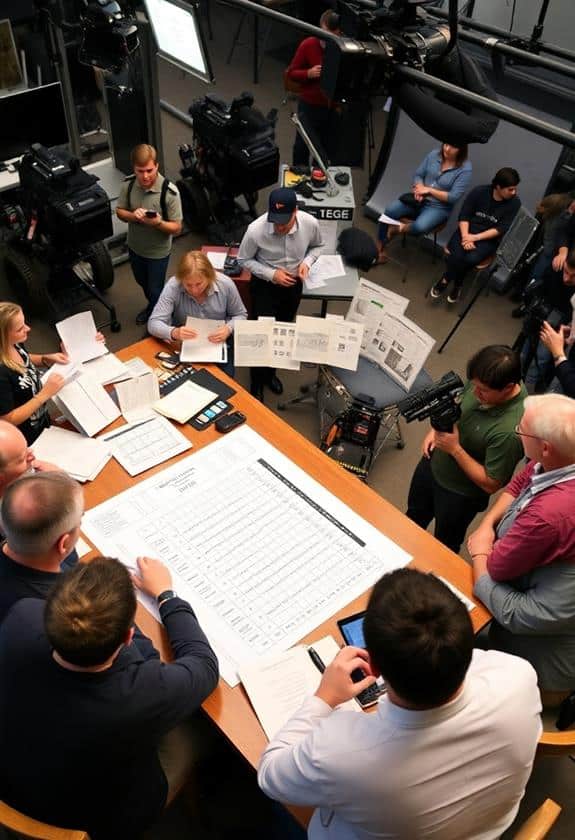
To effectively budget for your film, you need to grasp its scope thoroughly. Think of your film as a big puzzle. If you don’t know how many pieces you have, it’s tough to see the complete picture! Start by asking yourself some key questions: What’s the genre? How long is the film? Who’s your target audience? Knowing these elements will help you create a more accurate budget. Additionally, consider the essential filmmaking equipment you’ll need, such as 5 Easy and Low-Cost Equipment Essentials that can help streamline your production process. When I first started making films, I jumped in without fully understanding my project’s scope. I quickly learned that this led to unexpected costs that nearly derailed my project. Trust me, you don’t want to run out of funds halfway through shooting!
Break down your film into key areas like locations, cast, crew, and props. For instance, shooting in a well-known location can be exciting, but it often comes with higher fees and permits. By evaluating these factors early on, you’ll minimize surprises later.
Research Average Costs
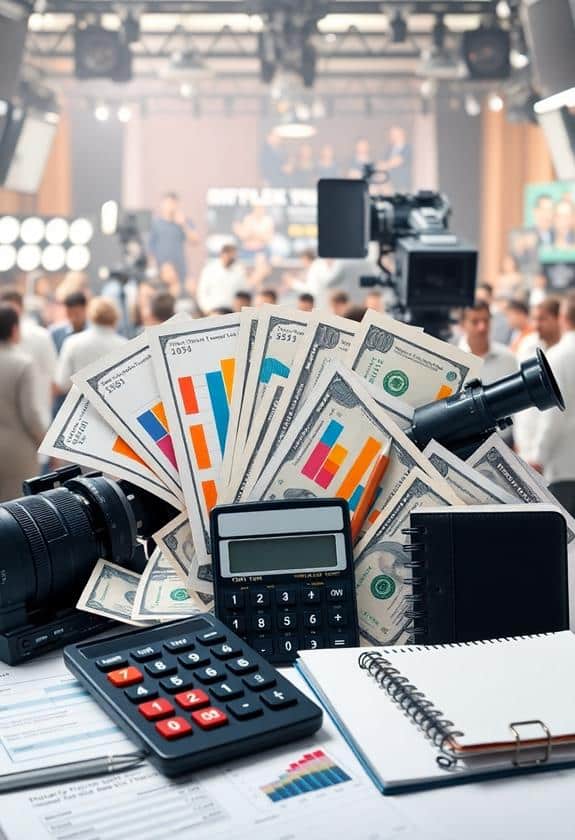
Researching average costs is vital for creating a realistic film budget. You might think it’s all about creativity, but let’s be honest: without knowing what things cost, your film could hit a financial wall. When I first started out, I was shocked at how quickly expenses piled up. I learned the hard way that a good budget is your safety net. It’s also important to take into account the types of equipment you’ll need, such as cameras that cater to aspiring filmmakers. For instance, you can find a range of options that suit various budgets and styles, including essential cameras for filmmakers.
Start by checking out industry reports or websites that specialize in film production costs. You’ll want to look at everything from equipment rentals to crew salaries. For example, did you know that hiring a skilled cinematographer can range from $500 to $2,000 a day? If you’re aiming to stay on budget, you need that kind of info.
Don’t hesitate to connect with fellow filmmakers or join online forums. They can offer valuable insights, and sometimes you’ll find out about local discounts or resources. Plus, sharing your experiences can lighten the load—everyone loves a good laugh over a budgeting blunder! Remember, the more you know about average costs, the better prepared you’ll be to bring your film vision to life, safely and confidently.
Identify Key Budget Categories
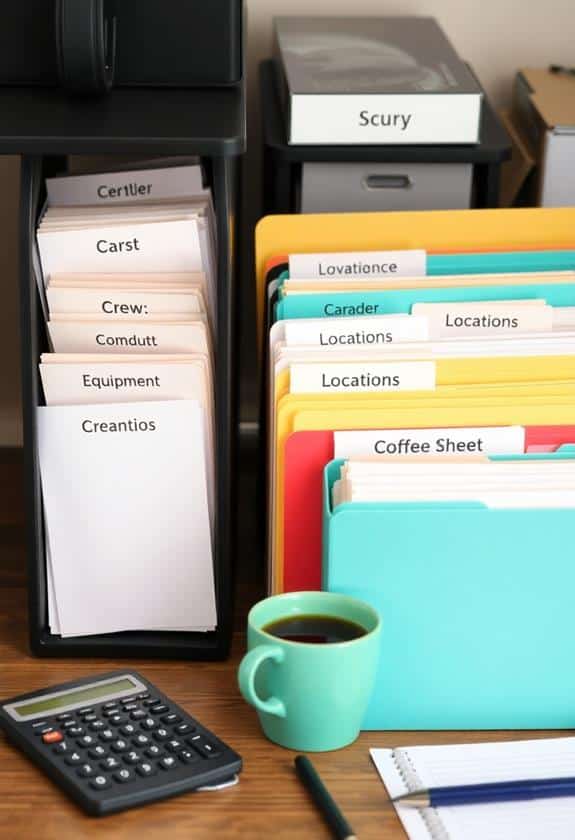
When planning your film budget, it’s crucial to identify key budget categories that will shape your financial strategy. These categories help you see where your money’s going and keep your project on track. Trust me, having these categories in mind can save you from unexpected surprises later on.
Here’s a simple breakdown of some key budget categories:
| Category | Description | Estimated Cost |
|---|---|---|
| Pre-Production | Costs for scripts, casting, and locations | $5,000 – $20,000 |
| Production | Expenses for crew, equipment, and sets | $30,000 – $100,000 |
| Post-Production | Editing, sound, and visual effects | $10,000 – $50,000 |
| Marketing | Promotion, festivals, and screenings | $5,000 – $15,000 |
Create a Detailed Line Item List

Creating a detailed line item list is essential for keeping your film budget organized and transparent. Think of it as your financial roadmap; every category you’ve identified needs specific attention. Break down your expenses into clear items like cast salaries, equipment rentals, and location fees. Additionally, consider the importance of high-quality audio; investing in the right gear, such as top microphones for filmmaking enthusiasts, can greatly enhance your production quality. This way, you’ll know exactly where your money’s going.
When I was working on my first short film, I underestimated how much I’d spend on props. I just jotted down “props” without details. Big mistake! By the time I finished, I was scrambling to cover unexpected costs. So, don’t make that error. Be specific—list each prop and its estimated cost.
Also, consider adding a column for notes. This can help you track why you chose certain items or how you might adjust costs later. You’re not just writing numbers; you’re telling the story of your film’s budget.
Lastly, keep your list accessible. Share it with your team, and update it regularly. This transparency keeps everyone on the same page and helps avoid any financial surprises. Remember, a well-organized budget is your best friend in filmmaking!
Factor in Contingency Funds
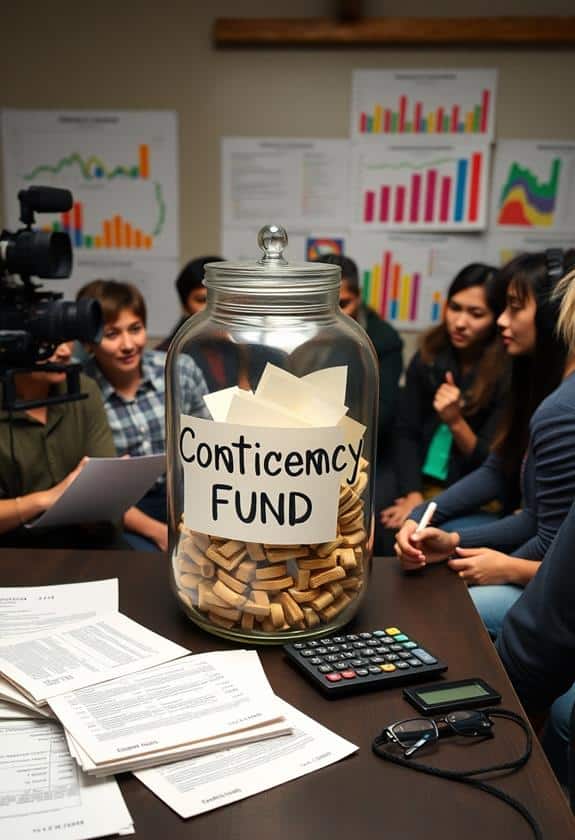
Contingency funds act as your safety net, ensuring you’re prepared for unexpected expenses that can arise during production. Think of them as your superhero sidekick, swooping in when things don’t go according to plan. Trust me, I learned this the hard way when a last-minute location change nearly wiped out my budget! It’s also wise to evaluate the costs of affordable equipment, which can help you stay within your budget while still achieving great production value. Affordable Filmmaking Gear can be a lifesaver when you’re trying to keep expenses in check.
So, how much should you set aside for these funds? A good rule of thumb is to allocate about 10-15% of your total budget. That way, if you face surprise costs, like equipment repairs or an unexpected crew meal, you won’t be scrambling to find extra cash.
Picture this: You’re filming a thrilling scene, and suddenly a downpour hits. You’ll need to cover the cost of tarps or even rescheduling. Having that contingency money means you can tackle these surprises without losing your cool.
Consider Pre-Production Expenses
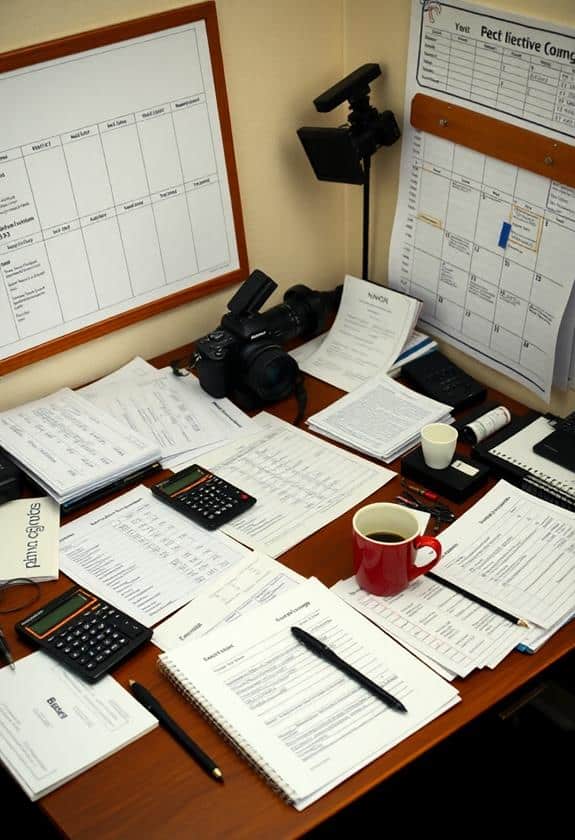
Before diving into production, it’s crucial to wrap your head around pre-production expenses, as they can greatly impact your overall budget. Imagine this: you’ve got your script, your cast, and all the excitement, but wait—what about the costs? Pre-production isn’t just about planning; it’s where you lay the groundwork for financial safety. You’ll need to evaluate location fees, permits, casting calls, and even equipment rentals, such as a reliable tripod for stabilization in your shots important gear for every filmmaker. Trust me, those little expenses add up faster than you think! I remember when I overlooked location permits on my first short film. It nearly cost me double when I had to scramble at the last minute!
To avoid that panic, make a detailed checklist of everything you’ll need. Think of it as your safety net, catching those hidden costs before they fall through the cracks. Also, don’t forget to allocate funds for marketing materials or creating a buzz about your film.
Plan for Production Costs
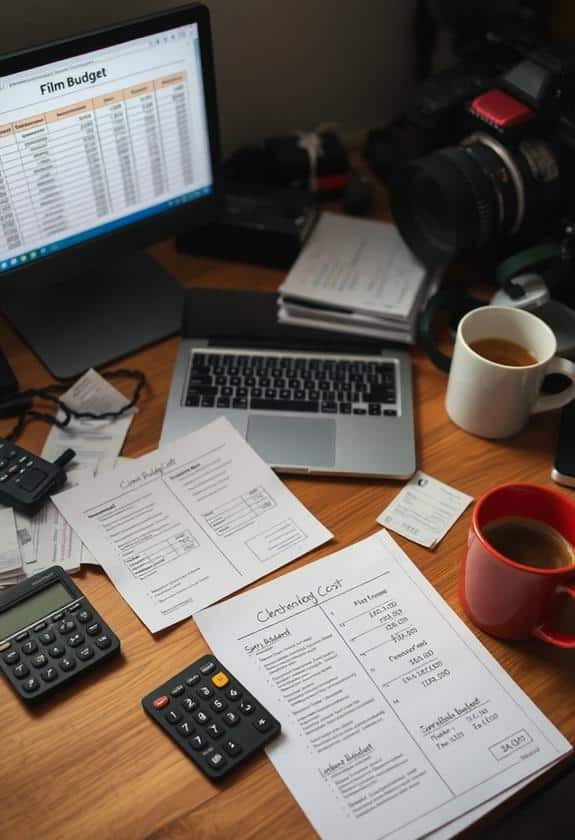
Planning for production costs is essential for keeping your film project on track. You don’t want to find yourself scrambling for funds halfway through shooting! Trust me, I’ve been there, and it’s not fun. Taking a bit of time to plan can save you from a lot of stress later. Here are some key areas to take into account when budgeting:
- Location Fees: Renting spaces can add up quickly, so be sure to scout affordable options.
- Equipment Rentals: Don’t forget about cameras, lights, and sound gear. Renting can be less expensive than buying!
- Crew Salaries: Pay your team fairly; they’re important to your project’s success.
- Costumes and Props: These can be pricey, especially if you want to create a specific atmosphere.
- Insurance: Protecting your project is essential. Look into production insurance to cover potential mishaps.
Account for Post-Production Fees
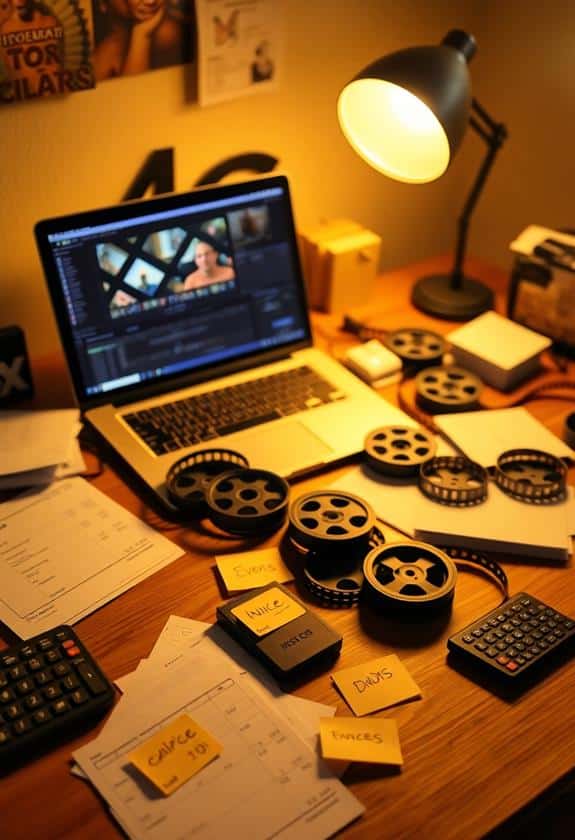
Once you’ve nailed down your production costs, it’s time to shift your focus to post-production fees. This part can feel a bit overwhelming, but don’t worry—it’s just another step in your filmmaking journey. You’ll need to budget for tasks like editing, sound design, and visual effects. Each of these can add up quickly, so it’s vital to plan ahead.
When I made my first short film, I underestimated editing costs. It felt like I was throwing money at a black hole! But I learned that getting quality editing is essential—it can elevate your film from good to great. Consider hiring a professional editor or using software that fits your budget.
Also, don’t forget about color correction and sound mixing; they might seem minor, but they can make a huge difference. Leaving a little wiggle room in your budget for these expenses is smart and will give you peace of mind.
Track Your Expenses Regularly
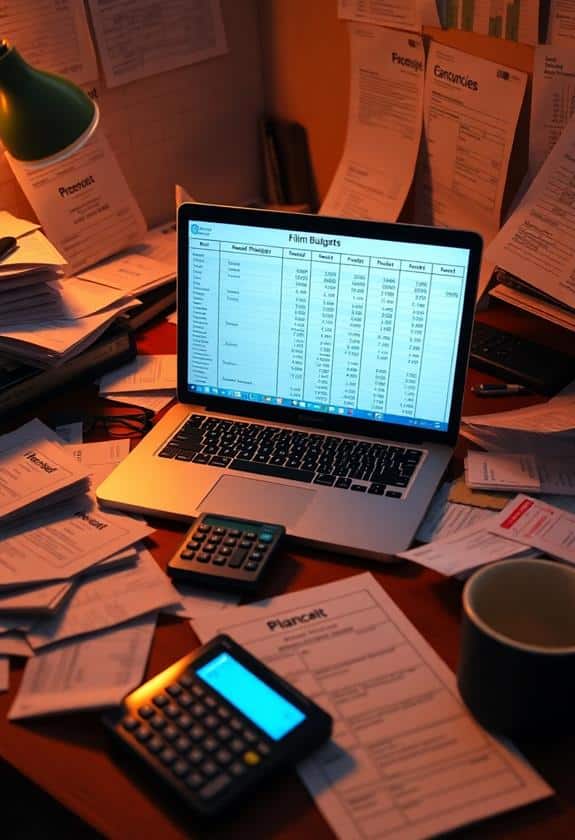
Keeping a close eye on your expenses is essential for maintaining control over your film budget. Imagine you’re on set, and the last thing you want is to run out of funds halfway through production. By tracking your expenses regularly, you can guarantee that every dollar spent is helping you achieve your vision. It’s like keeping a diary of your spending—only way more exciting!
Here are a few tips to help you stay on top of your expenses:
- Use a Spreadsheet: This can help you categorize costs and spot trends over time.
- Record Daily: Jot down expenses right after they happen to avoid forgetting later.
- Set a Weekly Review: Dedicate time each week to go over your spending.
- Create Categories: Group expenses into categories like equipment, cast, and locations to see where most of your budget goes.
- Stay Flexible: If you notice you’re overspending in one area, make a note and plan accordingly.
Adjust Your Budget as Needed

Frequently, you’ll find that your initial budget doesn’t align perfectly with the realities of production. It happens to all filmmakers, even the pros! You might discover unexpected costs, like last-minute equipment rentals or an urgent need for extra crew members. Don’t panic; adjusting your budget is part of the game.
Start by reviewing your expenses regularly. If you notice you’re overspending in one area, consider cutting back in another. For instance, if your location fees skyrocket, you might save money by using a friend’s backyard for a scene instead. It’s all about flexibility!
Also, set aside a small contingency fund—say, 10% of your overall budget. This safety net can help you tackle unforeseen expenses without derailing your entire project. Remember, every filmmaker faces hiccups, and being prepared will give you peace of mind.
Frequently Asked Questions
How Can I Secure Funding for My Film Project?
To secure funding for your film project, start by crafting a compelling pitch that highlights your passion and unique vision. You might consider reaching out to family and friends first; they can be your biggest supporters! Then, explore crowdfunding platforms like Kickstarter or Indiegogo, where you can share your story and connect with potential backers. Don’t forget to network at local film festivals—connections can lead to unexpected opportunities. Keep dreaming big!
What Should I Do if My Budget Exceeds Projections?
If your budget exceeds projections, don’t panic! First, reassess your expenses; there might be areas to cut back. Consider reaching out to friends or local businesses for sponsorship or donations. You could also explore crowdfunding platforms, where passionate supporters can chip in. Remember, every film has hiccups; I’ve faced budget woes too! Stay flexible and creative. With a little brainstorming, you’ll find a way to make your project shine!
Are There Grants Available for Indie Filmmakers?
You know, finding grants for indie filmmakers can feel like searching for the Holy Grail. But don’t worry, there are options out there! Organizations like the Sundance Institute and the Film Society offer grants that could help you out. Just remember to follow their guidelines carefully. It’s a bit like cooking; if you skip steps, your dish might not turn out right. So, plunge into it, apply, and keep that passion alive!
How Do I Prioritize Spending in My Budget?
When you’re prioritizing spending in your budget, start with the essentials. Think about what you need, like equipment and crew. Then, consider your location and permits. It’s like packing for a trip; you wouldn’t leave without your toothbrush! Don’t forget to set aside a little for unexpected surprises. Trust me, they’ll pop up! Balancing your passion with practicality can be tricky, but it’s key to making your film dream come true.
What Are the Common Financial Pitfalls in Filmmaking?
Think of filmmaking like sailing. If you don’t check your compass, you might drift into stormy waters. Common pitfalls include underestimating costs, overspending on flashy equipment, and neglecting marketing. I once splurged on a fancy camera, only to realize I’d skimped on essential editing software. Balance your resources wisely to avoid capsizing your project. Stay focused on what truly matters, and you’ll navigate the waters of filmmaking safely and successfully!
Conclusion
So, as you plunge into the exciting world of filmmaking, remember that budgeting is just as essential as your story. Think of it like crafting a delicious recipe; every ingredient matters! From planning your production costs to keeping an eye on those pesky post-production fees, staying organized will save you from surprises. Embrace the challenges, learn from them, and soon you’ll find that managing your film budget can be just as rewarding as watching your vision come to life on screen!




